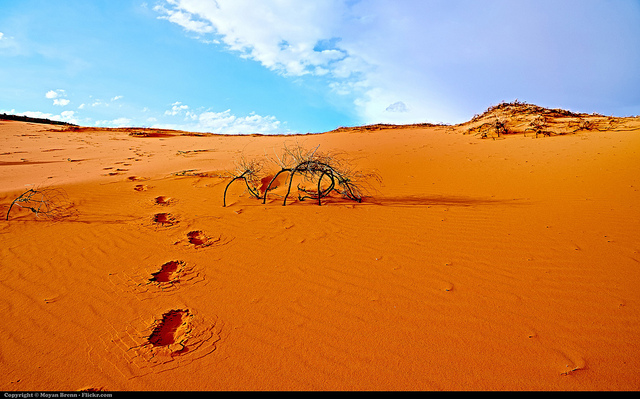Some traveler believe that planning ahead before traveling is overrated and not necessary, as they believe that all you have to do is have your backpack ready and go. For some of them this may work some of the time, and it may be a nice strategy to spontaneously travel without letting other things get in your way and persuade you from taking off. However, in some cases, the destination is place where you may not know what you are going to find, what type of weather you will encounter or if the camping areas are well suited; it is important then to know all of the details no matter how small they are and be well prepared for everything. In this article we want to talk about camping in desert zones; areas that bring new challenges to the table that may turn into a disaster if you are ill prepared.
It is very important to start by knowing which type of desert you are going to visit, which animals you can find and how far from civilization you will be camping so you can plan accordingly and be able to respond to any eventualities.
Types of deserts
All deserts have a reputation of having little to no water, or of being very hot, but all of that depends on the area you are visiting.
Coastal desert: these deserts are normally within a few kilometers from the ocean and they are generally not as dry. Rain varies a lot depending on the weather, but normally it rains about twice a week. The soil is sandy earth, which is good for setting up tents safely. They are characterized by having little rain, a long hot summer, a short and mild winter and temperatures vary between 24 and 95 degrees Fahrenheit. The wildlife is this type of desert usually hides during the day to conserve moisture but at night is common to see coyotes, toads, owls and other reptiles.
Semi-arid desert: these types of deserts have the driest weather and usually get more precipitation, something around 25 to 50 centimeters a year, which puts them in the category of semi-arid. They can be hot or cold depending of the area in the world where they are located. Semi-arid deserts are common in North America, Europe and Asia. You can find animals like rats, lizards, rabbits, badgers and other rodents.

Courtesy of Moyan Brenn at flickr.com
Dry and hot desert: in this type of deserts, temperature is very high reaching up to 120 degrees Fahrenheit and with precipitation of less than 1.5 centimeters a year. For this type of environment is very important to bring very light clothing of light color that covers all areas of skin so you aren’t exposed to the sun. It is normal to find many insects, spiders, rodents and birds that usually hide during the day but come out and hunt at night.
Polar desert: the winter in these deserts is long, dark and cold with temperatures below 50 degrees Fahrenheit during the warmest months of the year. When the summer comes, you may find swamp areas that form after some of the ice melts and it is the best time to go camping in this beautiful locations.
Tips for before, during and after
Sleeping bag: just like a good quality tent is important, so is a good sleeping bag made with adequate materials to be comfortable and safe. The shape is very important as well as there are sleeping bags that have less room for the feet, which make them great for conserving temperature and they also occupy less space when packing that regular rectangular sleeping bags that are heaving and bigger. Synthetic materials retain less moisture and are lighter as well so they work great for very humid areas, while those stuffed with feathers or light cotton are great for dry areas and colder climate.
Water consumption: Being in desert weather is always exhausting no matter the temperature, that is why you must always bring with you more water than you think you are going to need. It is important to keep track of your water consumption during the day to ensure that you are keeping yourself properly hydrated. Even if you aren’t thirsty, drink water the way your planned it out.
Don’t bring pets: it is fun to travel with your pets in a camping trip, but the desert is not a good place to bring them along. There are many dangers like plants they may eat or prick themselves with; also there are animals like coyotes that can be very dangerous and territorial. Dogs may hurt their paws in desert paths since they usually don’t wear protective shoes. Is best to let your furry friends sit this one out.
Utensils: When you arrive to your campsite, it is important to leave everything the way you found it, so bring along zip-lock bags to carry back your dirty clothes, trash and discarded food. A proper knife is important as well as survival tools to make fires, cook and many other situations that may call for it.
This is it for now; we will expand further at a later date with more information and tips about camping in different type of environment. For more information and tips to make your next vacation great, check out our blog at Royal Holiday Travel.

